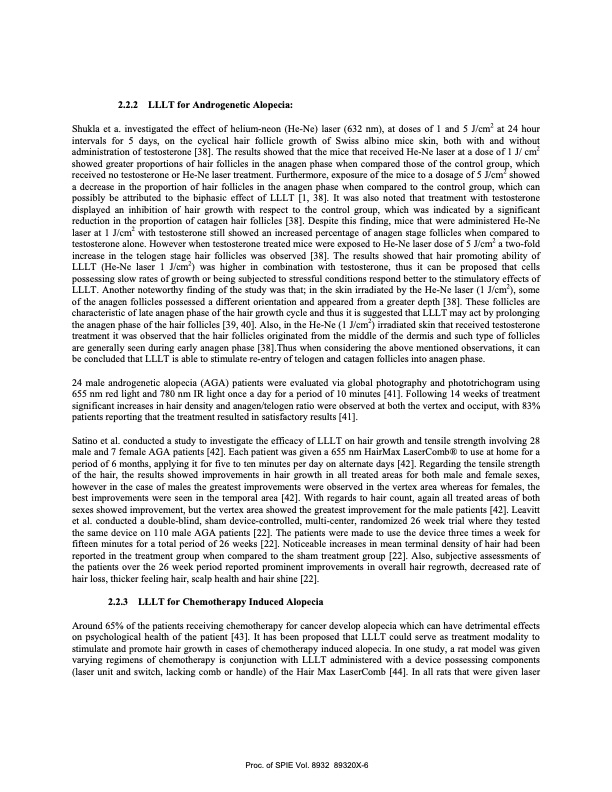
PDF Publication Title:
Text from PDF Page: 007
2.2.2 LLLT for Androgenetic Alopecia: Shukla et a. investigated the effect of helium-neon (He-Ne) laser (632 nm), at doses of 1 and 5 J/cm2 at 24 hour intervals for 5 days, on the cyclical hair follicle growth of Swiss albino mice skin, both with and without administration of testosterone [38]. The results showed that the mice that received He-Ne laser at a dose of 1 J/ cm2 showed greater proportions of hair follicles in the anagen phase when compared those of the control group, which received no testosterone or He-Ne laser treatment. Furthermore, exposure of the mice to a dosage of 5 J/cm2 showed a decrease in the proportion of hair follicles in the anagen phase when compared to the control group, which can possibly be attributed to the biphasic effect of LLLT [1, 38]. It was also noted that treatment with testosterone displayed an inhibition of hair growth with respect to the control group, which was indicated by a significant reduction in the proportion of catagen hair follicles [38]. Despite this finding, mice that were administered He-Ne laser at 1 J/cm2 with testosterone still showed an increased percentage of anagen stage follicles when compared to testosterone alone. However when testosterone treated mice were exposed to He-Ne laser dose of 5 J/cm2 a two-fold increase in the telogen stage hair follicles was observed [38]. The results showed that hair promoting ability of LLLT (He-Ne laser 1 J/cm2) was higher in combination with testosterone, thus it can be proposed that cells possessing slow rates of growth or being subjected to stressful conditions respond better to the stimulatory effects of LLLT. Another noteworthy finding of the study was that; in the skin irradiated by the He-Ne laser (1 J/cm2), some of the anagen follicles possessed a different orientation and appeared from a greater depth [38]. These follicles are characteristic of late anagen phase of the hair growth cycle and thus it is suggested that LLLT may act by prolonging the anagen phase of the hair follicles [39, 40]. Also, in the He-Ne (1 J/cm2) irradiated skin that received testosterone treatment it was observed that the hair follicles originated from the middle of the dermis and such type of follicles are generally seen during early anagen phase [38].Thus when considering the above mentioned observations, it can be concluded that LLLT is able to stimulate re-entry of telogen and catagen follicles into anagen phase. 24 male androgenetic alopecia (AGA) patients were evaluated via global photography and phototrichogram using 655 nm red light and 780 nm IR light once a day for a period of 10 minutes [41]. Following 14 weeks of treatment significant increases in hair density and anagen/telogen ratio were observed at both the vertex and occiput, with 83% patients reporting that the treatment resulted in satisfactory results [41]. Satino et al. conducted a study to investigate the efficacy of LLLT on hair growth and tensile strength involving 28 male and 7 female AGA patients [42]. Each patient was given a 655 nm HairMax LaserComb® to use at home for a period of 6 months, applying it for five to ten minutes per day on alternate days [42]. Regarding the tensile strength of the hair, the results showed improvements in hair growth in all treated areas for both male and female sexes, however in the case of males the greatest improvements were observed in the vertex area whereas for females, the best improvements were seen in the temporal area [42]. With regards to hair count, again all treated areas of both sexes showed improvement, but the vertex area showed the greatest improvement for the male patients [42]. Leavitt et al. conducted a double-blind, sham device-controlled, multi-center, randomized 26 week trial where they tested the same device on 110 male AGA patients [22]. The patients were made to use the device three times a week for fifteen minutes for a total period of 26 weeks [22]. Noticeable increases in mean terminal density of hair had been reported in the treatment group when compared to the sham treatment group [22]. Also, subjective assessments of the patients over the 26 week period reported prominent improvements in overall hair regrowth, decreased rate of hair loss, thicker feeling hair, scalp health and hair shine [22]. 2.2.3 LLLT for Chemotherapy Induced Alopecia Around 65% of the patients receiving chemotherapy for cancer develop alopecia which can have detrimental effects on psychological health of the patient [43]. It has been proposed that LLLT could serve as treatment modality to stimulate and promote hair growth in cases of chemotherapy induced alopecia. In one study, a rat model was given varying regimens of chemotherapy is conjunction with LLLT administered with a device possessing components (laser unit and switch, lacking comb or handle) of the Hair Max LaserComb [44]. In all rats that were given laser Proc. of SPIE Vol. 8932 89320X-6PDF Image | Low-level light therapy (LLLT) for cosmetics and dermatology

PDF Search Title:
Low-level light therapy (LLLT) for cosmetics and dermatologyOriginal File Name Searched:
Sawhney-LLLT-esthetics.pdfDIY PDF Search: Google It | Yahoo | Bing
Cruise Ship Reviews | Luxury Resort | Jet | Yacht | and Travel Tech More Info
Cruising Review Topics and Articles More Info
Software based on Filemaker for the travel industry More Info
The Burgenstock Resort: Reviews on CruisingReview website... More Info
Resort Reviews: World Class resorts... More Info
The Riffelalp Resort: Reviews on CruisingReview website... More Info
| CONTACT TEL: 608-238-6001 Email: greg@cruisingreview.com | RSS | AMP |